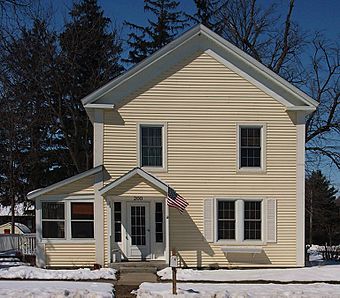Edward T. Archibald House facts for kids
The Edward T. Archibald House is a historic home located in Dundas, Minnesota, United States. This private house was added to the National Register of Historic Places (NRHP) on June 17, 1976. Built in the 1860s, the house is important because of its connection to Edward T. Archibald. He was a famous miller whose nearby Archibald Mill played a big role in Minnesota's flour milling industry.
Quick facts for kids |
|
|
Edward T. Archibald House
|
|

The Edward T. Archibald House from the southeast
|
|
| Location | 200 2nd Street South, Dundas, Minnesota |
|---|---|
| Area | less than one acre |
| Architect | Hamblin, Lorenzo |
| Architectural style | Greek Revival |
| NRHP reference No. | 76001072 |
| Added to NRHP | June 17, 1976 |
Contents
About the House
The Edward T. Archibald House is found on the southwest corner of 2nd Street and Hamilton Street in Dundas. It's a two-story building made of wood. The house is built in a simple Greek Revival architecture style. This style often includes features like columns and a grand entrance. The house has a gable roof, which means it has two sloping sides that meet at a ridge.
The outside of the house is covered with clapboard siding. This is a type of wooden board that overlaps to protect the house from weather. Originally, the house had a special "service wing." This was a part of the house where servants would work or live. However, only the main part of the house remains today. There was also a wooden stable and carriage barn on the property. But this building was later taken down. Other homes were built where it once stood.
A Look at History
The Edward T. Archibald House was first built in the 1860s by Lorenzo Hamblin. Edward T. Archibald bought the house and lived there from 1867 to 1885. Archibald was a very important person in the milling world. People in his time called him "The man or firm who takes the leading place among flour makers of this country or of the world."
Founding Dundas
Even though some people lived there before them, Edward T. Archibald and his brother John Sidney, along with their cousin George Archibald, officially founded the town of Dundas in 1867. They named the town after their hometown, Dundas, Ontario, in Canada. The Archibalds built large mills on both sides of the Cannon River. These mills were key to making Dundas a famous milling center.
Famous Flour from Dundas
The flour made at the Archibald Mill was known as the best in the United States. This was because of the great care taken during its making. Their special flour, called "Dundas straight," was sold for more money in New York City and Boston than flour from Minneapolis. Because of this, millers from Minneapolis would visit Dundas. They wanted to learn the secrets of the Archibald Mill.
New Ideas in Milling
Edward T. Archibald was always looking for new ways to improve his mills. He wanted to keep up with the competition from Minneapolis. In 1879, he updated his mills to use rollers. This was also known as the "Hungarian milling process." Using rollers helped the mills make more flour while keeping its high quality. The Archibald Mill was one of the first to fully use this new roller system. During this time, the Archibald mills were at their most important in the world of flour milling.
Revolutionizing Wheat Farming
John Sidney Archibald was a very forward-thinking miller. He brought three barrels of Red Fife wheat from Canada. The Archibald family then worked to develop this seed. It became the "No. 1 hard spring wheat." This new type of wheat completely changed farming in Minnesota. Before 1860, most wheat grown in the U.S. was "soft winter wheat." But spring wheat was much better for Minnesota's soil.
At first, spring wheat was hard to use because it was very tough. It also had a lot of "middlings." Middlings are small pieces of the wheat kernel that are left after the first grinding. With the old grinding methods used before 1870, the hard spring wheat would heat up too much. Its thin, brittle outer layer would also break into tiny pieces. These pieces would get into the flour and make it look discolored.
To fix this problem, the Archibalds changed how their millstones worked. They ran the millstones at a slower speed. They also set them higher so they would only crack the wheat kernel during the first grinding. The wheat was then ground several more times. This new process made the middlings the most valuable part of the product. This was important because gluten, which helps bread rise and adds nutrition, is found in the middlings. The Archibalds' mills were also among the first to use the middlings purifier. This machine was developed in Minneapolis. It allowed mills to make large amounts of high-gluten flour.
Later Years
Edward T. Archibald moved to nearby Northfield in 1885. The mill complex in Dundas burned down on New Year's Eve in 1892. But it was quickly rebuilt. It burned down again in 1914. After being rebuilt once more, the mill was sold as the milling industry started to slow down. The special patents and ideas from the Archibald mills were later sold to what is now General Mills.
Images for kids




